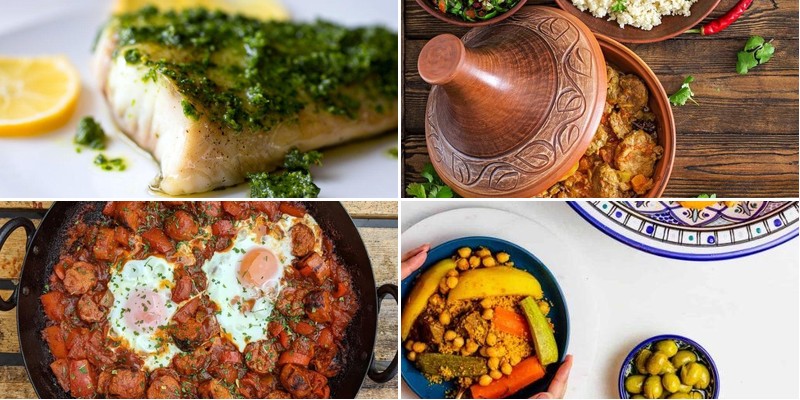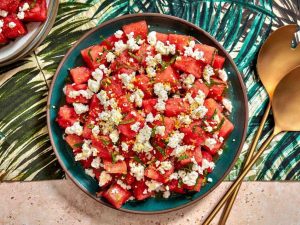Buckle up, flavor adventurers! If you’re craving something new and exciting in your kitchen, you’ve come to the right place. Tunisian cuisine is a vibrant explosion of spices, fresh ingredients, and comforting dishes that will transport your taste buds. We’ve gathered 19 authentic recipes that are surprisingly easy to make at home. Get ready to discover your new favorite meals—let’s dive into this delicious journey together!
Tunisian Shakshuka with Harissa
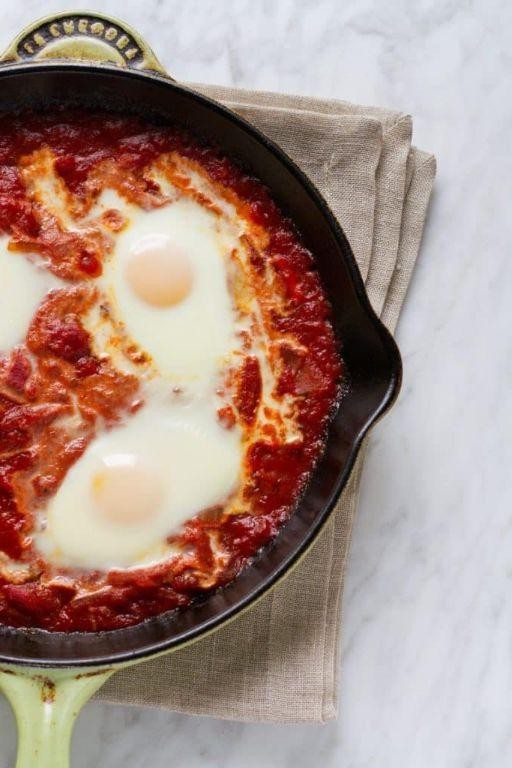
Remembering how the morning light used to fall across my grandmother’s kitchen table, I find myself drawn to the warmth of this dish—a gentle simmer of tomatoes and spices that feels like a quiet conversation with the past. Really, it’s the kind of meal that asks you to slow down, to notice the way the eggs set just so in their crimson bed, a small comfort on any unhurried morning.
Ingredients
- Olive oil – 2 tbsp
- Yellow onion – 1 medium, diced
- Garlic – 3 cloves, minced
- Canned crushed tomatoes – 28 oz
- Harissa paste – 2 tbsp
- Ground cumin – 1 tsp
- Paprika – 1 tsp
- Salt – 1 tsp
- Eggs – 4 large
- Fresh parsley – ¼ cup, chopped
Instructions
- Heat olive oil in a 10-inch skillet over medium heat until it shimmers, about 1 minute.
- Add diced onion and cook, stirring occasionally, until translucent and soft, 5–7 minutes.
- Stir in minced garlic and cook until fragrant, 30 seconds—be careful not to let it brown.
- Pour in crushed tomatoes, harissa paste, cumin, paprika, and salt, stirring to combine.
- Reduce heat to low, cover, and simmer for 15 minutes until the sauce thickens slightly and the flavors meld.
- Use the back of a spoon to create 4 small wells in the sauce for the eggs.
- Crack 1 egg into each well, spacing them evenly apart in the skillet.
- Cover the skillet and cook over low heat for 7–9 minutes, or until the egg whites are fully set but the yolks remain runny—check by gently jiggling the pan.
- Sprinkle chopped parsley over the top just before serving.
Velvety egg yolks mingle with the smoky, spiced tomato base, creating a dish that’s both robust and delicate. I love scooping it straight from the skillet with thick, toasted bread, or spooning it over creamy polenta for a comforting twist.
Spicy Tunisian Couscous with Vegetables

Dusk settles outside my kitchen window as I prepare this dish, the steam rising from the pot carrying scents that feel both foreign and deeply familiar. There’s something comforting about the ritual of preparing couscous, each grain swelling with flavor until the whole kitchen smells of distant places and home all at once.
Ingredients
- Couscous – 1 cup
- Vegetable broth – 1 ¼ cups
- Olive oil – 2 tbsp
- Onion – 1 medium, diced
- Garlic – 2 cloves, minced
- Carrot – 1 large, chopped
- Zucchini – 1 medium, chopped
- Chickpeas – 1 can (15 oz), drained
- Harissa paste – 1 tbsp
- Cumin – 1 tsp
- Salt – ½ tsp
- Black pepper – ¼ tsp
- Fresh parsley – 2 tbsp, chopped
- Lemon – 1, juiced
Instructions
- Heat olive oil in a large saucepan over medium heat until it shimmers.
- Add diced onion and cook for 5 minutes, stirring occasionally, until translucent.
- Stir in minced garlic and cook for 1 minute until fragrant.
- Add chopped carrot and cook for 4 minutes, stirring every minute.
- Mix in harissa paste and cumin, coating the vegetables evenly.
- Pour in vegetable broth and bring to a boil over high heat.
- Reduce heat to low, cover the saucepan, and simmer for 8 minutes.
- Add chopped zucchini and drained chickpeas to the saucepan.
- Cover and simmer for 6 minutes until zucchini is tender but still firm.
- Remove the saucepan from heat and stir in couscous, salt, and black pepper.
- Cover the saucepan tightly and let stand for 7 minutes to allow couscous to absorb liquid.
- Fluff the couscous with a fork to separate the grains.
- Stir in fresh parsley and lemon juice until evenly distributed.
Soft grains of couscous cradle the tender vegetables, each bite carrying the warm hum of harissa that builds slowly rather than overwhelms. The chickpeas add substance while the lemon brightens everything, making this equally satisfying served warm in deep bowls or at room temperature the next day, perhaps with a dollop of yogurt to tame the heat for more sensitive palates.
Brik à l’œuf with Tuna and Capers
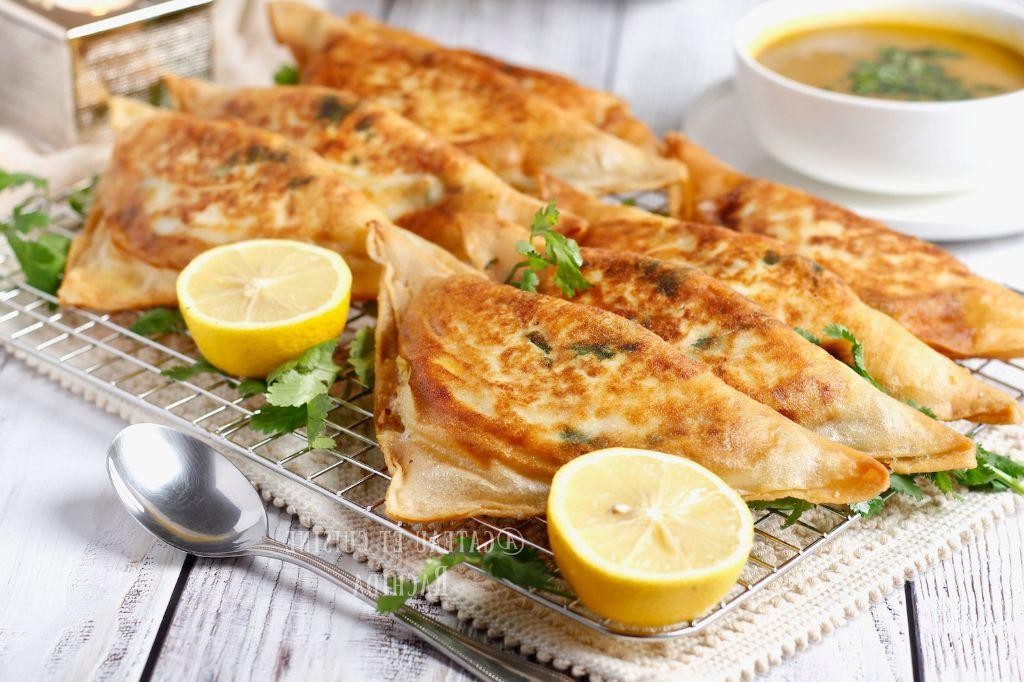
Maybe it’s the way the morning light falls across the kitchen counter, or the quiet anticipation of something simple yet extraordinary, but today feels right for this particular recipe. There’s something deeply comforting about the ritual of folding delicate pastry around humble ingredients, creating a pocket of warmth and flavor that feels both familiar and exotic.
Ingredients
– Phyllo dough – 4 sheets
– Canned tuna – 1 cup
– Capers – 2 tbsp
– Eggs – 4
– Olive oil – ¼ cup
– Salt – ½ tsp
Instructions
1. Lay one phyllo dough sheet flat on a clean work surface, keeping remaining sheets covered with a damp towel to prevent drying.
2. Brush the entire surface of the phyllo sheet lightly with olive oil using a pastry brush.
3. Place a second phyllo sheet directly on top of the first oiled sheet.
4. Spoon ¼ cup of tuna in the center of the stacked phyllo sheets, leaving a 3-inch border around all edges.
5. Sprinkle ½ tablespoon of capers evenly over the tuna.
6. Carefully crack one egg directly over the tuna and caper mixture.
7. Season the egg with a pinch of salt.
8. Fold the bottom edge of the phyllo up over the filling, then fold the top edge down to create an envelope.
9. Fold the left side over, then the right side, completely enclosing the filling.
10. Repeat steps 1-9 with remaining ingredients to make three more pastries.
11. Heat 2 tablespoons of olive oil in a large skillet over medium heat until it shimmers.
12. Place one pastry seam-side down in the hot oil and cook for 3 minutes until golden brown.
13. Flip the pastry carefully using a spatula and cook for another 3 minutes until the second side is golden brown and the egg white is set.
14. Remove from skillet and drain on paper towels.
15. Repeat cooking process with remaining pastries, adding more oil as needed.
What emerges from the skillet is pure magic—the phyllo becomes impossibly crisp and shatteringly delicate, while inside, the egg yolk remains gloriously runny, mingling with the briny capers and savory tuna. Serve these warm, perhaps with a simple green salad or alongside roasted vegetables for a complete meal that feels both rustic and refined.
Tabil Seasoned Chicken Tajine

Now, as the autumn light filters through my kitchen window, I find myself drawn to the gentle rhythms of slow cooking, the way spices bloom and stories unfold in the steam rising from a heavy pot. This Tabil seasoned chicken tajine feels like a quiet conversation with tradition, each ingredient adding its whisper to the chorus.
Ingredients
Chicken thighs – 1.5 lbs
Olive oil – 2 tbsp
Onion – 1 large, chopped
Garlic – 3 cloves, minced
Tabil seasoning – 2 tbsp
Chicken broth – 1 cup
Carrots – 2 medium, sliced
Salt – 1 tsp
Instructions
1. Pat the chicken thighs completely dry with paper towels to ensure proper browning.
2. Heat olive oil in a tajine or heavy-bottomed pot over medium-high heat until it shimmers.
3. Place chicken thighs skin-side down and cook for 6-7 minutes until deeply golden brown.
4. Flip chicken and cook for another 4 minutes, then transfer to a plate.
5. Add chopped onion to the same pot and cook for 5 minutes until translucent.
6. Stir in minced garlic and cook for 1 minute until fragrant.
7. Sprinkle tabil seasoning over the onions and toast for 30 seconds to release its aroma.
8. Pour in chicken broth, using a wooden spoon to scrape any browned bits from the bottom of the pot.
9. Return chicken thighs to the pot along with any accumulated juices.
10. Arrange sliced carrots around the chicken in a single layer.
11. Sprinkle salt evenly over everything.
12. Reduce heat to low, cover the tajine, and simmer for 45 minutes.
13. Check the chicken internal temperature reaches 165°F using an instant-read thermometer.
14. Remove from heat and let rest for 10 minutes before serving.
Perhaps what I love most is how the chicken becomes impossibly tender, falling away from the bone while the carrots soak up all the warm, earthy spices. Serving it over couscous that catches the fragrant sauce feels like gathering autumn in a bowl, each bite layered with the quiet comfort of slow-cooked memories.
Lablabi: Tunisian Chickpea Soup

There’s something quietly comforting about a bowl of soup that feels like a warm embrace, especially when it carries the gentle, earthy flavors of Tunisian kitchens. This lablabi, with its humble chickpea base, is one of those soul-soothing dishes that simmers patiently, filling the air with a cumin-scented promise of simplicity and nourishment. It’s the kind of meal that asks for nothing more than a quiet moment and a willing spoon.
Ingredients
Chickpeas – 2 cups
Water – 6 cups
Garlic – 3 cloves
Cumin – 1 tbsp
Olive oil – 2 tbsp
Salt – 1 tsp
Lemon – 1
Instructions
1. Rinse 2 cups of chickpeas under cold running water for 1 minute to remove any dust or impurities.
2. Combine the rinsed chickpeas and 6 cups of water in a large pot over high heat.
3. Bring the pot to a rolling boil, which should take about 8–10 minutes.
4. Reduce the heat to low, cover the pot with a lid, and simmer for 1 hour and 30 minutes until the chickpeas are tender when pressed with a fork.
5. Mince 3 cloves of garlic finely while the chickpeas simmer.
6. Heat 2 tablespoons of olive oil in a small skillet over medium heat for 1 minute.
7. Add the minced garlic to the skillet and sauté for 2 minutes until fragrant and lightly golden.
8. Stir in 1 tablespoon of cumin and cook for 30 seconds to toast the spices, which deepens their flavor.
9. Stir the garlic-cumin mixture into the simmering chickpea pot.
10. Add 1 teaspoon of salt to the pot and stir to combine evenly.
11. Simmer the soup uncovered for another 10 minutes to allow the flavors to meld.
12. Cut 1 lemon in half and squeeze the juice directly into the pot, stirring gently.
13. Remove the pot from the heat and let it rest for 5 minutes before serving.
You’ll notice the broth has thickened slightly from the softened chickpeas, creating a velvety texture that carries the warm, earthy notes of cumin and the bright zing of lemon. For a cozy twist, try ladling it over toasted crusty bread in your bowl—the bread soaks up the fragrant broth, turning each bite into a comforting, hearty experience.
Tunisian Grilled Merguez Sausages

Zestful memories of distant spice markets come drifting back whenever I prepare these sausages, their smoky aroma filling the kitchen like a warm embrace on quiet afternoons when time seems to stretch endlessly before me.
Ingredients
– Merguez sausages – 1 lb
– Olive oil – 2 tbsp
– Ground cumin – 1 tsp
– Lemon – 1
Instructions
1. Preheat your grill to medium-high heat, approximately 400°F, ensuring the grates are clean and lightly oiled to prevent sticking.
2. Pat the merguez sausages completely dry with paper towels—this helps achieve better browning and prevents steaming.
3. Brush each sausage lightly with 1 tablespoon of olive oil, coating all sides evenly for consistent cooking.
4. Place the sausages diagonally across the grill grates, creating attractive crosshatch marks by rotating them 45 degrees after 2 minutes.
5. Grill for 4-5 minutes per side, until the internal temperature reaches 160°F and the casings are crisp with visible char lines.
6. Sprinkle the remaining 1 tablespoon of olive oil mixed with ground cumin over the hot sausages immediately after removing them from the grill.
7. Squeeze the juice of one lemon directly over the sausages while they rest for exactly 3 minutes to allow juices to redistribute.
8. Cut each sausage on the bias into ½-inch thick slices, revealing the beautifully marbled interior.
Gently caramelized edges give way to tender, spiced lamb that carries whispers of harissa and garlic, perfect for tucking into warm pita with crisp cucumber or scattered over couscous studded with roasted peppers.
Mechouia Salad with Peppers and Tomatoes
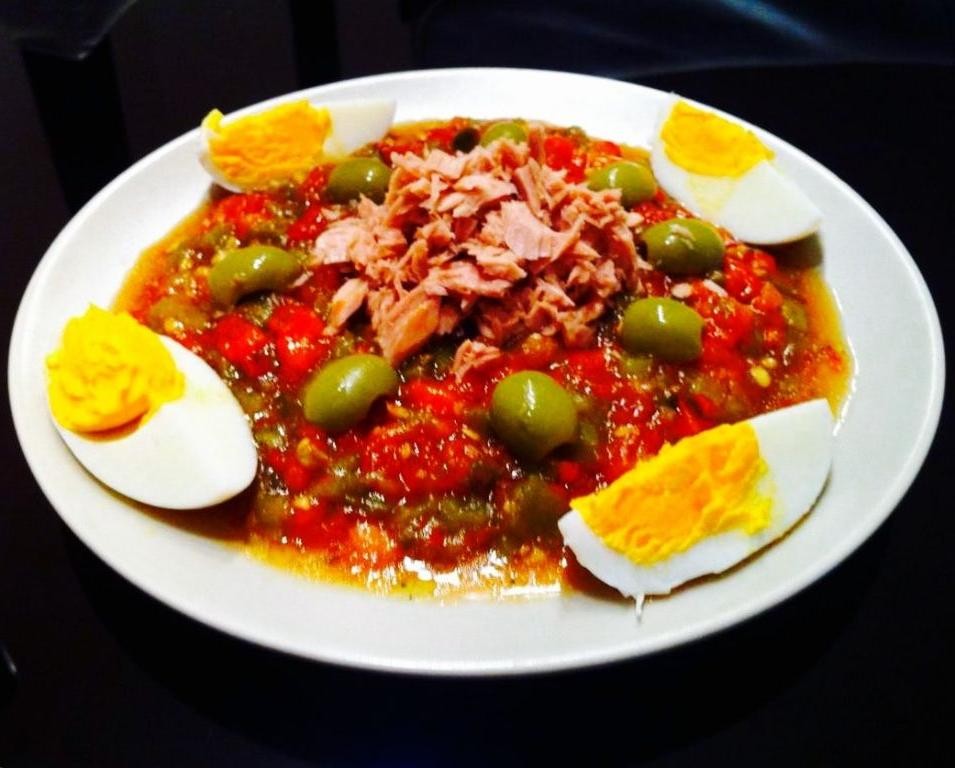
There’s something quietly grounding about preparing a dish that asks you to slow down, to let the ingredients speak for themselves in their own time. Mechouia salad, with its charred peppers and tomatoes, feels like a gentle conversation with summer’s bounty—a reminder that the simplest transformations often yield the most soulful flavors.
Ingredients
Bell peppers – 4 large
Tomatoes – 3 medium
Garlic – 3 cloves
Olive oil – ¼ cup
Salt – 1 tsp
Cumin – 1 tsp
Lemon juice – 2 tbsp
Instructions
1. Preheat your oven to 450°F.
2. Arrange the bell peppers and tomatoes on a baking sheet.
3. Roast the vegetables for 25–30 minutes, turning them halfway through, until the skins are blistered and blackened in spots.
4. Transfer the roasted peppers and tomatoes to a bowl and cover it tightly with plastic wrap for 10 minutes—this steams them, making the skins easier to peel.
5. Peel the skins off the peppers and tomatoes, then discard the skins.
6. Slice the peeled peppers into thin strips.
7. Chop the peeled tomatoes into small pieces.
8. Mince the garlic cloves finely.
9. In a mixing bowl, combine the sliced peppers, chopped tomatoes, and minced garlic.
10. Drizzle the olive oil over the vegetable mixture.
11. Sprinkle the salt and cumin evenly over the ingredients.
12. Add the lemon juice to the bowl.
13. Gently toss everything together until well combined.
14. Let the salad sit at room temperature for at least 15 minutes to allow the flavors to meld.
You’ll notice the peppers retain a slight crunch against the soft, juicy tomatoes, while the cumin and garlic lend a warm, earthy depth. Try serving it alongside grilled fish or spooned over crusty bread for a simple, vibrant meal that feels both rustic and refined.
Traditional Tunisian Lamb Stew
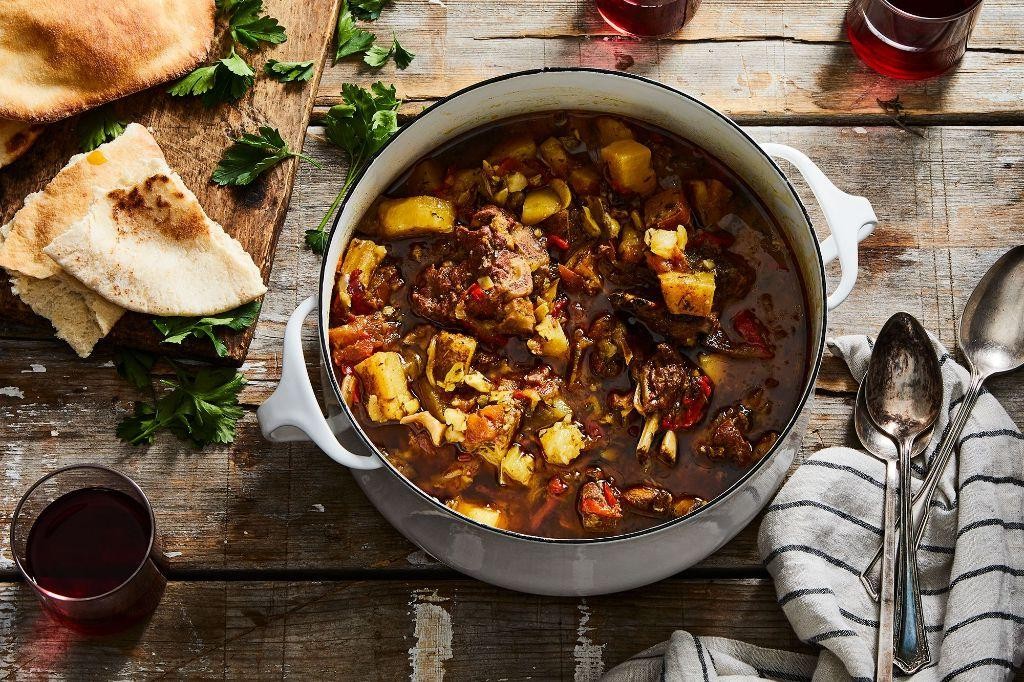
Perhaps there’s something quietly profound about a stew that has simmered for generations, its story told in the gentle steam rising from a heavy pot on a cool autumn evening. This traditional lamb stew from Tunisia feels less like a recipe and more like a slow, deliberate conversation with time itself, each ingredient adding its own soft-spoken verse to the narrative.
Ingredients
Lamb shoulder – 2 lbs
Olive oil – 2 tbsp
Yellow onion – 1 large
Garlic – 4 cloves
Tomato paste – 2 tbsp
Ground cumin – 1 tsp
Paprika – 1 tsp
Cayenne pepper – ¼ tsp
Potatoes – 2 large
Carrots – 3 medium
Chicken broth – 4 cups
Salt – 1 tsp
Black pepper – ½ tsp
Instructions
1. Cut the lamb shoulder into 1-inch cubes, trimming away any large pieces of fat.
2. Heat olive oil in a large Dutch oven over medium-high heat until it shimmers.
3. Pat the lamb cubes dry with paper towels to ensure proper browning.
4. Brown the lamb in batches for 3-4 minutes per side until deeply caramelized.
5. Transfer the browned lamb to a clean plate, leaving the drippings in the pot.
6. Dice the yellow onion into ½-inch pieces.
7. Sauté the onion in the lamb drippings for 6-8 minutes until translucent.
8. Mince the garlic cloves finely.
9. Add the minced garlic to the onions and cook for 1 minute until fragrant.
10. Stir in tomato paste and cook for 2 minutes until it darkens slightly in color.
11. Add ground cumin, paprika, and cayenne pepper, toasting the spices for 30 seconds.
12. Return the browned lamb and any accumulated juices to the pot.
13. Peel and cut the potatoes into 1-inch chunks.
14. Peel and slice the carrots into ½-inch thick rounds.
15. Add the potatoes and carrots to the Dutch oven.
16. Pour in chicken broth, ensuring it just covers the ingredients.
17. Season with salt and black pepper, stirring gently to combine.
18. Bring the stew to a gentle boil over high heat.
19. Reduce heat to low, cover the pot, and simmer for 2 hours until the lamb is fork-tender.
20. Remove the lid and simmer uncovered for 15 minutes to slightly thicken the broth.
For the final moments, the stew settles into itself—the lamb becomes impossibly tender, falling apart at the slightest pressure, while the potatoes soak up the rich, spiced broth. Flavors deepen into something earthy and complex, with the gentle heat of cayenne warming rather than overwhelming. Serve it over couscous to catch every drop of the aromatic sauce, or with crusty bread for dipping into the deeply satisfying broth.
Stuffed Bell Peppers with Spiced Rice

Evenings like this make me want to fill the kitchen with the earthy scent of roasting peppers, their colorful shells waiting to cradle something warm and nourishing. There’s a quiet comfort in preparing stuffed bell peppers, each one becoming its own little vessel of spiced rice and gentle flavors, perfect for these slowly darkening autumn days.
Ingredients
Bell peppers – 4 large
Olive oil – 2 tbsp
Onion – 1 medium, diced
Garlic – 2 cloves, minced
Ground beef – 1 lb
Long-grain white rice – 1 cup
Beef broth – 2 cups
Tomato paste – 2 tbsp
Chili powder – 1 tsp
Cumin – ½ tsp
Salt – 1 tsp
Black pepper – ½ tsp
Shredded cheddar cheese – 1 cup
Instructions
1. Preheat your oven to 375°F.
2. Cut the tops off the bell peppers and remove all seeds and membranes.
3. Brush the outside of each pepper with 1 tablespoon of olive oil.
4. Place the peppers cut-side up in a baking dish just large enough to hold them snugly.
5. Heat the remaining 1 tablespoon of olive oil in a large skillet over medium heat.
6. Add the diced onion and cook for 4 minutes until translucent.
7. Add the minced garlic and cook for 1 minute until fragrant.
8. Add the ground beef and cook for 6 minutes, breaking it up with a spoon until no pink remains.
9. Stir in the uncooked rice, beef broth, tomato paste, chili powder, cumin, salt, and black pepper.
10. Bring the mixture to a simmer, then reduce heat to low, cover, and cook for 15 minutes until the rice has absorbed most of the liquid.
11. Remove the skillet from heat and stir in ½ cup of shredded cheddar cheese.
12. Spoon the rice mixture evenly into the prepared bell peppers, packing it gently.
13. Top each pepper with the remaining ½ cup of shredded cheddar cheese.
14. Pour ¼ cup of water into the bottom of the baking dish around the peppers.
15. Cover the dish tightly with aluminum foil and bake for 30 minutes.
16. Remove the foil and bake for another 15 minutes until the peppers are tender and the cheese is golden brown.
17. Let the peppers rest for 5 minutes before serving.
Perhaps what I love most is how the peppers soften into sweet, yielding vessels while the rice maintains just enough bite against the melted cheese. The spiced beef creates a warm foundation that makes each bite feel complete, especially when served with a simple green salad to cut through the richness.
Tunisian Ojja with Merguez and Eggs

Yesterday’s rain left the kitchen windows steamed, and I found myself craving something that would warm from the inside out, something simple yet deeply comforting.
Ingredients
– Olive oil – 2 tbsp
– Merguez sausage – 8 oz
– Yellow onion – 1 medium, chopped
– Garlic – 3 cloves, minced
– Canned crushed tomatoes – 1 (14.5 oz) can
– Harissa paste – 1 tbsp
– Eggs – 4 large
– Salt – ½ tsp
– Fresh parsley – ¼ cup, chopped
Instructions
1. Heat olive oil in a 10-inch skillet over medium heat for 1 minute.
2. Add merguez sausage, breaking it into small pieces with a wooden spoon, and cook for 6–8 minutes until browned and cooked through.
3. Add chopped onion and cook for 5 minutes, stirring occasionally, until softened and translucent.
4. Stir in minced garlic and cook for 1 minute until fragrant.
5. Pour in crushed tomatoes and harissa paste, stirring to combine.
6. Reduce heat to low, cover the skillet, and simmer for 15 minutes to allow flavors to meld.
7. Create 4 small wells in the sauce using the back of a spoon.
8. Crack 1 egg into each well, being careful not to break the yolks.
9. Sprinkle salt evenly over the eggs and sauce.
10. Cover the skillet and cook for 5–7 minutes until egg whites are fully set but yolks are still runny.
11. Remove from heat and sprinkle with chopped parsley.
Zesty and richly spiced, this dish cradles softly set eggs in a smoky tomato embrace. The merguez lends a gentle heat that lingers, while the runny yolks create a sauce of their own. Try scooping it directly from the skillet with crusty bread for a truly communal meal.
Baklawa with Almond and Pistachio Filling
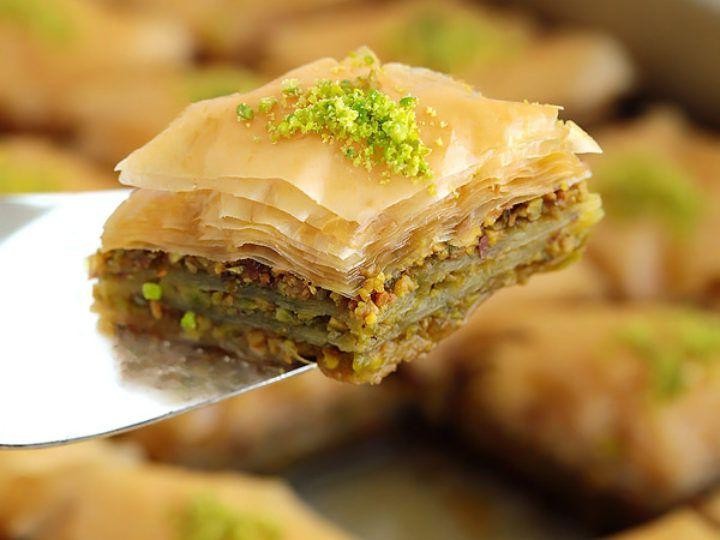
Pausing here in the quiet kitchen, I find myself reaching for the familiar comfort of layered dough and nuts, the way sunlight falls across the counter suggesting something sweet and slow to unfold. There’s a gentle rhythm to making baklawa, each step a small meditation, and today I’m filling it with almonds and pistachios for a delicate crunch. Let’s begin, just you and me, with soft hands and patience.
Ingredients
Phyllo dough – 1 package (16 oz)
Unsalted butter – 1 cup, melted
Almonds – 1 ½ cups, finely chopped
Pistachios – 1 ½ cups, finely chopped
Sugar – 1 cup
Water – ½ cup
Lemon juice – 1 tbsp
Orange blossom water – 1 tsp
Instructions
1. Preheat your oven to 350°F. 2. Brush a 9×13-inch baking dish lightly with melted butter. 3. Lay one sheet of phyllo dough in the dish. 4. Brush the phyllo sheet thoroughly with melted butter. 5. Repeat steps 3 and 4 until you have 8 buttered phyllo layers. 6. Combine the almonds and pistachios in a bowl. 7. Spread the nut mixture evenly over the phyllo layers. 8. Top the nuts with another phyllo sheet. 9. Brush this sheet with melted butter. 10. Continue layering and buttering phyllo sheets until you have 8 more layers on top. 11. Using a sharp knife, cut the baklawa into diamond or square shapes, cutting through all layers. 12. Bake in the preheated oven for 45 minutes, or until the top is golden brown and crisp. 13. While baking, combine sugar, water, and lemon juice in a saucepan. 14. Bring the syrup to a boil over medium heat, stirring until sugar dissolves. 15. Reduce heat and simmer for 10 minutes, without stirring, until slightly thickened. 16. Remove syrup from heat and stir in orange blossom water. 17. Let the syrup cool completely to room temperature. 18. Once baklawa is out of the oven, immediately pour the cooled syrup evenly over the hot pastry. 19. Allow the baklawa to sit at room temperature for at least 4 hours to fully absorb the syrup. Buttery layers shatter delicately with each bite, releasing the warm, toasty fragrance of almonds and pistachios. For a lovely twist, serve it slightly warmed with a dollop of thick yogurt or a sprinkle of crushed rose petals to echo the floral syrup.
Fish Fillet with Chermoula Marinade
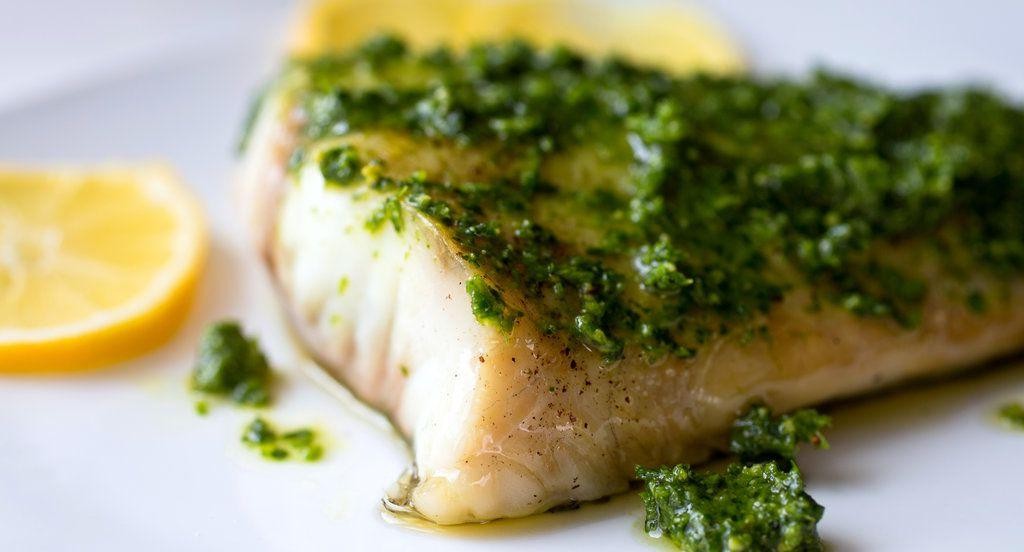
Floating through the quiet kitchen this morning, I found myself drawn to the gentle rhythm of preparing this dish, the way the marinade stains the fish like watercolor on paper, creating something beautiful from simple beginnings.
Ingredients
White fish fillets – 1 lb
Fresh cilantro – ½ cup packed
Garlic – 3 cloves
Lemon juice – 2 tbsp
Olive oil – ¼ cup
Ground cumin – 1 tsp
Paprika – 1 tsp
Salt – ¾ tsp
Black pepper – ¼ tsp
Instructions
1. Combine cilantro, garlic, lemon juice, olive oil, cumin, paprika, salt, and black pepper in a blender.
2. Blend the mixture on high speed for 45 seconds until it forms a smooth, vibrant green paste.
3. Pat the fish fillets completely dry with paper towels to ensure the marinade adheres properly.
4. Place the fish fillets in a shallow dish and coat both sides evenly with the chermoula marinade.
5. Cover the dish with plastic wrap and refrigerate for exactly 30 minutes to allow flavors to penetrate.
6. Preheat your oven to 400°F while the fish marinates.
7. Transfer the marinated fish to a baking sheet lined with parchment paper after the 30-minute marinating time.
8. Bake the fish for 12-15 minutes until the edges turn golden brown and the flesh flakes easily with a fork.
9. Check for doneness by inserting a fork at the thickest part – the fish should appear opaque throughout.
10. Let the fish rest for 3 minutes before serving to allow the juices to redistribute evenly. Perhaps what I love most is how the chermoula forms a delicate crust that crackles between your teeth, giving way to the tender flakiness beneath. Pair it with couscous that soaks up the vibrant sauce, or serve it alongside roasted vegetables for a complete meal that feels both nourishing and celebratory.
Fricassé: Tunisian Fried Sandwich

Keeping my kitchen quiet this morning, I find myself drawn to the simple comfort of handheld meals, the kind that warm both palms and heart with each careful bite. Fricassé feels like one of those recipes that holds stories in its folds—a Tunisian fried sandwich that’s humble yet deeply satisfying, perfect for a slow, thoughtful day.
Ingredients
– All-purpose flour – 2 cups
– Active dry yeast – 1 tsp
– Warm water – ¾ cup
– Salt – ½ tsp
– Vegetable oil – 2 cups
– Canned tuna – 1 can (5 oz)
– Hard-boiled eggs – 2
– Harissa – 1 tbsp
– Capers – 1 tbsp
– Lemon juice – 1 tsp
Instructions
1. Combine 2 cups all-purpose flour, 1 tsp active dry yeast, and ½ tsp salt in a large bowl.
2. Gradually pour in ¾ cup warm water (about 110°F) while stirring with a wooden spoon until a shaggy dough forms.
3. Knead the dough on a floured surface for 8–10 minutes until smooth and elastic. Tip: If the dough sticks to your hands, lightly dust them with flour—this prevents over-adding and keeps the texture light.
4. Place the dough in a lightly oiled bowl, cover with a damp cloth, and let rise in a warm spot for 1 hour or until doubled in size.
5. Punch down the risen dough and divide it into 4 equal pieces.
6. Roll each piece into a 6-inch circle about ¼-inch thick on a floured surface.
7. Heat 2 cups vegetable oil in a deep skillet to 350°F, checking with a thermometer for accuracy.
8. Fry one dough circle at a time for 2–3 minutes per side until golden brown and puffed. Tip: Don’t overcrowd the pan—frying in batches ensures even cooking and a crisp exterior.
9. Drain the fried bread on a wire rack or paper towels to keep it from getting soggy.
10. In a small bowl, mix 1 can drained tuna, 2 chopped hard-boiled eggs, 1 tbsp harissa, 1 tbsp capers, and 1 tsp lemon juice until well combined.
11. Slice each fried bread circle halfway through horizontally to create a pocket. Tip: Use a serrated knife and saw gently to avoid tearing the delicate interior.
12. Stuff each pocket generously with the tuna mixture, pressing lightly to secure.
Something about the crisp, golden shell giving way to the soft, spiced filling feels like a small revelation. The harissa lends a gentle heat that lingers, while the briny capers cut through the richness—try serving it with a side of olive-studded salad for a bright contrast, or simply enjoy it warm, the flavors melting together in your hands.
Conclusion
Whether you’re craving hearty stews, vibrant salads, or fragrant pastries, this collection brings the warmth of Tunisia to your kitchen. We hope these 19 authentic recipes inspire your next culinary adventure! Try them out, leave a comment with your favorite, and share this delicious roundup on Pinterest to spread the flavor.
